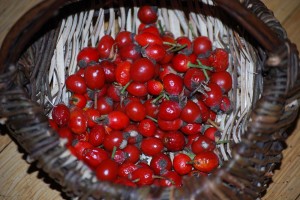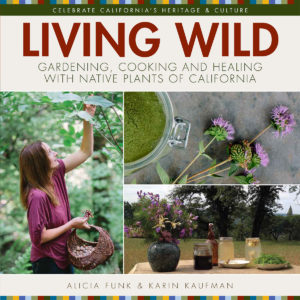Wild Roses
Driving an old levee road I’d not visited for some time, I chanced upon a bramble that looked different from the blackberries and wild grapes so common on the Delta. I caught a glimpse of a bright red berry, so surprising in November that I slowed my car and noticed it was a small, bulb-looking fruit. It took me a second to realize – wild roses! As my gaze expanded from that one, tiny hip, I saw that the entire patch was covered in a delicious Fall fruit.
California’s wild roses (9 species in the genus Rosa) provide quick and easy forage for essential nutrients and great taste during a season when these characteristics, in tandem, grow scarce. Wild roses are easy to identify – they look just like domestic roses, but with smaller flowers and fewer petals – and their hips are easy to gather.
Some guidebooks recommend picking wild rose hips after first frost. On the Delta, where frosts rarely come, they are ready when they turn bright red, and still good after a couple of months on the plant. I stop picking them when they turn completely black.
Rose hips taste great right off the plant as a “nibble” – like an apple with a citrus tang. Only eat the flesh, as the seeds are unpalatable. They offer vitamin C and other vitamins and minerals in significant quantities.
Rose hips really shine when cooked. Whether syrup, glaze, or tea, wild rose hips bring a unique flavor: a subtle aroma that both stands out by itself and enhances other flavors in the dish. A typical rose-hip experience involves pancakes, which is great, but don’t stop there: wild rose hips can glaze anything from green beans to walnuts, from fish to duck. And their flavor and properties as a tea are legendary.
Preparing wild rose hips is easy. Cut off and discard any green parts and stems and cover the hips with water. Bring to a boil and simmer until they get really soft and mushy, and then strain out the juice.
Wild rose bushes offer another valuable gift: their shoots. Wild rose shoots often grow exceptionally straight, making wonderful ‘stavelets’ – thin, strong, flexible shafts for building small trellises or arrows. I’ve made arrows for my nephew and daughter’s homemade bows, and when fletched with discarded feathers from our laying ducks, they fly fast and true. To prepare wild rose shoots, find the straightest shoots without branches, cut them at their base, knock off the thorns and strip the bark (easily done with a sharp machete). They bend fairly well and work as a green wood. If you are making arrows, bundle them together in groups of a half dozen or so and set them in a dry, warm corner of the house. Every couple of days, straighten the shoots by hand or wait a few weeks and straighten with dry heat. Place feathers on the skinny end of the shoot.
Wild roses exemplify California’s bounty of plants, providing us with an opportunity to connect with this land and place.
Joshua Stark is a naturalist, guide, outdoorsman and environmental advocate. His blogs, on ethics and the environment and home agrarianism, can be found at Agrarianista and Enviroethics.





